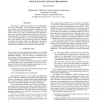Free Online Productivity Tools
i2Speak
i2Symbol
i2OCR
iTex2Img
iWeb2Print
iWeb2Shot
i2Type
iPdf2Split
iPdf2Merge
i2Bopomofo
i2Arabic
i2Style
i2Image
i2PDF
iLatex2Rtf
Sci2ools
ICMCS
2000
IEEE
2000
IEEE
Water-Filling for Watermarking?
In this paper we address the question: Is water-filling appropriate for watermarking? The water-filling paradigm is a traditional solution to the capacity maximization of parallel zero-mean additive white Gaussian channels subject to a signal energy constraint. In this work, we take an information theoretic approach to analyze the watermark communication problem in the presence of perceptual coding. Our effective watermark channel is modeled as a set of parallel independent zero-mean uniformly distributed additive noise channels. Energy allocation principles are identified to maximize the capacity results. Our findings are compared to the traditional water-filling solution and shed light on strategies to maximize the data hiding rate in the presence of compression.
Additive Noise Channels | ICMCS 2000 | Multimedia | Watermark Communication Problem | White Gaussian Channels |
| Added | 31 Jul 2010 |
| Updated | 31 Jul 2010 |
| Type | Conference |
| Year | 2000 |
| Where | ICMCS |
| Authors | Deepa Kundur |
Comments (0)

